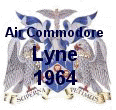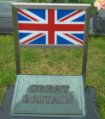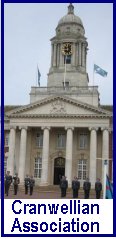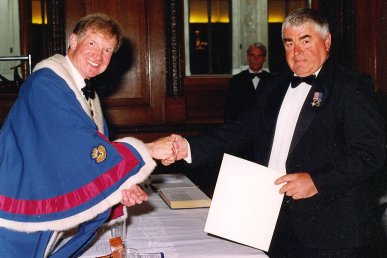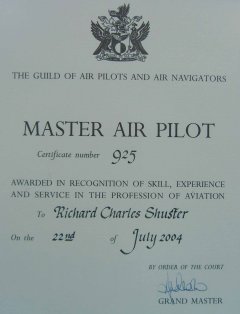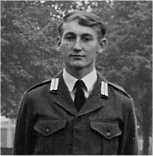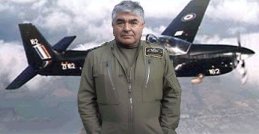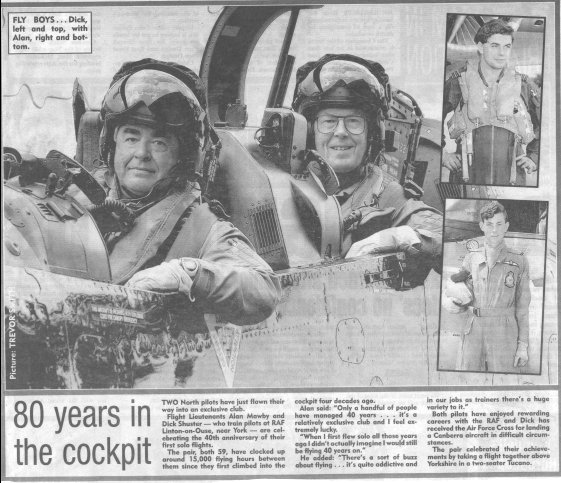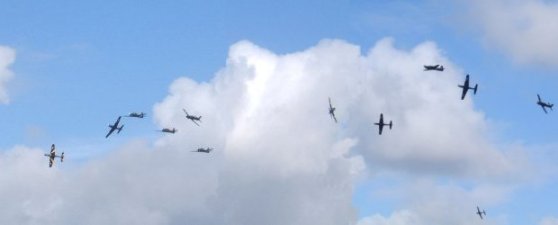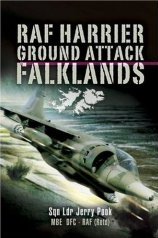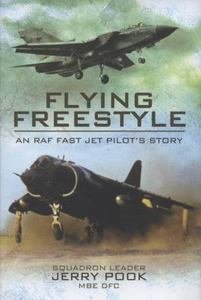|
Email your photos & stories |
|
For the Korean War site by Simon Coy
|
Cranwell
LINKS
Some news from 2004 to 2008
Index (Click on the subject)
89er appointed to Imperial War Museum & Commonwealth War Graves Commission
89's first Deputy Lord Lieutenant
89ers' collect their bus passes
89's last "Bang Seat" pilot retires
Peter appointed Chairman of the Imperial War Museum &
Vice Chairman of the Commonwealth War Graves Commission
|
It was officially announced on 19 December 2005 that the Prime Minister had re-appointed Air Chief Marshal Sir Peter Squire to the Board of the Imperial War Museum for a further four years from 19 December. In fact Peter is not simply a a trustee, with effect from 8th June Peter was appointed Chairman of the Trustees. |
 |
The Imperial War Museum was founded in 1917 to "record the story of the Great War" and was set up under the Imperial War Museum Acts of 1920 and 1925. Its remit was later extended to cover the Second World War and further expanded to all military operations involving British or Commonwealth forces since August 1914. (The official Press Release stated that Trustees of the Imperial War Museum are not remunerated, so there's no point in trying to bum drinks off Peter on the strength of it - we all need to buy him one for the excellent job they do!)
To view the Imperial War Museum website click here
Commonwealth War Graves Commission
Peter has been a Commissioner since 2003, but was promoted to Chairman with effect from April 2005. The official press release was as follows....
Air Chief Marshal Sir Peter Squire GCB DFC AFC DSc has been appointed as Vice-Chairman of the Commonwealth War Graves Commission with effect from April 2005 - succeeding General Sir John Wilsey GCB CBE DL on the completion of his term.
On his appointment Sir Peter said; "I feel extremely proud to accept the appointment of Vice-Chairman. The Commission does a wonderful job of ensuring that the sacrifices of those who gave their lives for freedom are not forgotten. In more recent years we have risen to the challenge of engaging new generations in that work and the act of remembrance.
"There is much still to do and I look forward to continuing the fine work of my predecessors and trust that my colleagues, the staff and I will continue to strengthen the Commission to meet the challenges of the future, whilst remaining true to the traditional highest standards of commemoration for the Commonwealth's war dead."
The Editor suspects that all our members have visited at least one Commonwealth War Grave Cemetery and that, like him, we can't fail to admire the quality of the work done in maintaining them throughout the world. The Editor has visited many in Europe, Far East & North Africa. These range in size from a site in Luxembourg where the two man crew of a PR Mosquito are buried, to Tyne Cot cemetery in Ypres, Belgium where over 20,000 soldiers are commemorated. We congratulate Peter and his international team on the terrific work that they do.
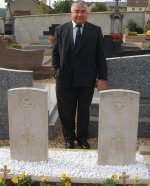 |
Left - Dick Shuster visiting a War Grave site on the Luxembourg side of the Mosel. It has just two graves. The significance of these are that they are the crew of a PR Mosquito - Flt Lt D.D.Hall (Pilot age 24) & F.O. B.R.Dwyer (Navigator age 20) who where shot down over Germany on the 2nd September 1944 - the day Dick (a future PR pilot) was born! Right - Tyne Cot, Ypres |
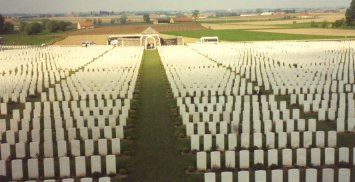 |
The Commonwealth War Graves Commission is responsible for marking and maintaining the graves of those members of the Commonwealth forces who died during the two world wars, for building and maintaining memorials to the dead whose graves are unknown and for providing records and registers of these 1.7 million burials and commemorations found in most countries throughout the world. Visit www.cwgc.org for more information.
The one major war of the 20th century that claimed thousands of Commonwealth lives, but whose graves and memorials are not maintained by the Commonwealth War Graves Commission is the Korean War! However, thanks to 89's Simon Coy they are remembered and listed in detail on the internet. Click Here for Details - Well done Simon.
Our congratulations go to Dick Shuster for being only the 925th pilot/navigator since 1926 to be awarded a Master Air Pilot's Certificate by the Guild of Aviation.
|
Dick receives his certificate from the Master of the Guild |
|
Master Air Pilot/Master Air Navigator Certificates - Criteria .....
The award of this certificate, signed by the Grand Master, Prince Andrew, The Duke of York, is an honour to a pilot or navigator, not necessarily a member of the Guild, who has in the opinion of the Court displayed over a number of years those qualities of pilotage, air navigation, airmanship and character which have brought honour and respect to the profession.
The award is in recognition of long service and consistently high standards in one or more branches of professional flying, whether civil or military, including air transport, flying instruction, test or operational flying.
As the title suggests, the recipient will be a proven Master of his craft.
Editor's Note - Dick's (long suffering) wife, Shireen, has asked me to make it clear that all the information about Dick comes from her & not from Dick who is too modest/embarrassed to pass it on - she has to smuggle the information and photographs out to me at great risk but in the true Cranwell tradition. So any other 89 wives, girl friends or mistresses out there who have photos, citations or other bumf on their husbands or lovers could they please email it to editor@89entry.co.uk or send it to 89 Entry, c/o AMCO, PO Box 138, York, YO61 3WS - All photos, etc will be returned.) |
|
Congratulations go to Andy Griffin (89B) who was appointed a Deputy Lord Lieutenant of Rutland on 8th April - Is this a first for 89? The official notice was published on Monday 18th April in the London Gazette - the following is an extract .... Deputy Lieutenant Commissions Commissions signed by HM Lord-Lieutenant of
the county of Rutland to be Deputy Lieutenants for the county of Rutland: |
 |
|
"
I was amazed to find your site listing all the news of the reprobates from 89
entry at Cranwell, and shocked to see how good looking I once was from
the 89A entry photograph!
Even though I just did the first year at Cranwell, and then managed to get
them to send me to Imperial College to study Aero Engineering as an APO, while
the rest of you were still earning £4 10s 6d a month (if my memory serves me
well) - I still have fond memories of my time there.
|
A good looking Graham! |
New archive photos
arrive... From Down Under
| Courtesy of John Liddell
in Melbourne, we have received more photographs to remind us of those hard
days back in the 60's when Paul MacCartney was busking in a cellar back in my
home town, Liverpool, whilst
we were locked in "Sleaford Tech" polishing floors, boots, brasses..... in
fact anything that moved or didn't move! (Shame that "Sleaford Tech"
was just it's nickname - had been the real name it would now be Sleaford
University and we'd all have honours degrees in Bull ---- ! )
But
eventually, as John's photographs show, we did get to do what most of us had
joined the RAF to do..... Fly!
John produced all these photographs when your Editor (acting unpaid) met up with him and his wife Glynis in Oz! I can report that both are fit and well and have been living in Melbourne for many years. Unfortunately we only had time for a quick breakfast meeting, but spent it reminiscing about the good old days. John produced an album with lots of interesting photographs and memorabilia. Many of these photographs are now published on the website. - If any one else has any hidden away - please let me have them. LWQ |
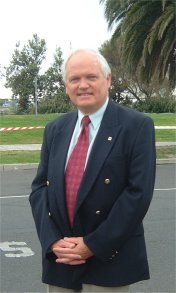 |
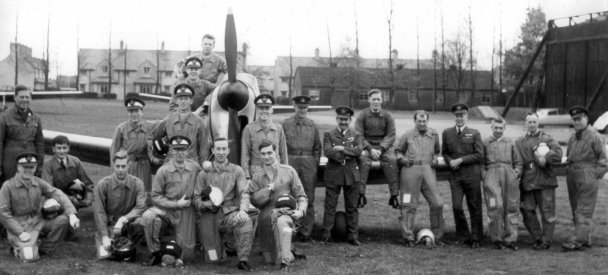
89 "A3" Flight
(Courtesy of John Liddell)
Go to the "Archives", "Survival", "Flying" or "C Sqn" page to see the new photographs.
The best photograph of our 1964 "Survival"?

Yankee 1 earning a trip to the pub - the hard way!
(This photograph was recently resurrected by Duncan Swift to remind us of the "fun" of survival!)
89 start collecting their bus passes!!!
Dick Shuster (Left) shows off his "Bus Pass" to the amusement of
Les Quigley, Chris Saunby, Jerry Pook and Brian Synott.
(Les [548] & Chris [549] were both born on Trafalgar Day 1944 and were also
about to qualify for their bus passes!)
89's Last "Bang Seat" Pilot Retires
|
Friday 30th July 2004 saw 89's last "bang seat" pilot Dick Shuster fly his last sortie before finally retiring from the RAF. Dick had retired once back in 1997, but had stayed on in the same job as an RAF(VR) officer being paid as a Civil Servant. (In Dick's case definitely a contradiction in terms - "Civil" - very rarely, and then only when so drunk that he couldn't speak! "Servant" - Never!! However, as Dick says, he was being paid for his favourite hobby, so they could call him anything they liked! .... And often did!!) |
Dick Shuster |
Dick leaves the RAF holding many of 89's records....
First to get a gong - the AFC at 23 (Click here to read the citation)
Longest serving RAF College Cranwell graduate in the rank of Flight Lieutenant - 35 years
Highest and fastest consumer of alcohol - and never had a hangover!! (Or never remembers having had one since he was still drunk next morning!)
The oldest RAF pilot ever to lead an RAF formation - At age 59 years 9 months
Most hours strapped to a bang seat - over 9,500 Hrs
Last 89 pilot to fly RAF Jet aircraft as PIC - 30th August 2004
THE OLDEST FORMATION IN THE RAF

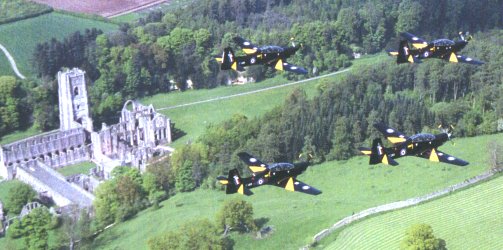 |
89's Dick Shuster, the oldest Tucano pilot in the RAF, leads a formation of 4 aircraft past Rivaulx, the oldest Abbey in North Yorkshire.
The average age of the pilots was over 59. |
The event was unique and attracted a lot of media attention being featured in the press, on Radio and on TV. They even managed to dig up some early photographs of a steely young Shuster ....
|
|
|
|
Above - The rumor was that it was going to be a bigger formation - but some of the younger chaps had difficulty joining - or was it those aggressive fighter pilot tactics Dick had taught them?
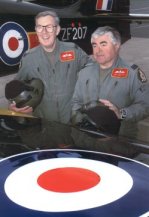 |
LEFT - Dick (right) poses with Allan Mawby (left) for a
final "oldest buggers in the RAF" press shot.
RIGHT - Dick returns from his last sortie to hang up his helmet! The last of the 89 few!!! |
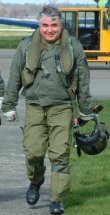 |
Jerry's Falkland's War Diaries Feature
in December's
![]()
The December edition of Flypast magazine contains an article on Harriers which amongst other things has extracts from Jerry Pook's Falkland's War diaries. The following is an extract from the initial publicity....
|
"Jack Talliss includes extracts from the diaries of Sqn Ldr Jerry Pook DFC written at the time of the Falklands action which provide a detailed account of the RAF’s part in "Operation Corporate" |
||||
|
||||
Pete Squire's Falkland's diaries were published several years ago and can be found by clicking on the following address :- www.raf.mod.uk/falklands/1sqn_index.html
The Falkland's Campaign 25 years on!
In 2005 Alfred Price, whilst reviewing the Falkland's war, wrote....
RAF Harriers were originally sent to the Falklands configured for air defence duties. Attrition of the Navy's Sea Harriers was lower than anticipated, and so the RAF's GR. Mk 3s were switched to interdiction sorties. They made an enormous contribution to the British victory, despite remaining unsung and overshadowed by the more glamorous Sea Harriers..........
"Without prior notice you are to modify the aircraft of your ground-attack squadron, and train your pilots, to operate in the air-to-air fighting role from an aircraft carrier though no carrier will be available for training and none of your pilots has previous experience in carrier flying. Then re-deploy 10 aircraft with spares and ground crews to a remote island 4,000 miles from your base. Do all of this within 3 1/2 weeks of the order to start. On the next day six of your aircraft are to land on the deck of a container ship anchored off the island; these will remain on deck for a two-week voyage to the operational area, during which no engine runs or anything other than minor servicing will be possible. Once in the operational area the aircraft will take off from the container ship and land on an aircraft-carrier nearby. After one day to familiarize itself with carrier operating procedures, your squadron is to go to into action. The unit will fly between six and 12 attack missions on each day the weather allows, with a total of 126 tasked missions during a 3 1/2 week period. You will have only 18 ground servicing specialists to keep your aircraft flying; all battle damage must be repaired using only the facilities available on the carrier. If aircraft are lost in action, replacements must be flown 3,800 miles from the remote island to the aircraft-carrier with no land diversions along almost the entire route.'
If that order had been given to the commander of a ground-attack squadron anywhere in the world on 1 April 1982, he would probably thought it an April fool's joke. Almost certainly his reply, in whatever language, would have been a curt 'impossible'. Yet this was the task given to Wing Commander Peter Squire, the commander of No.1 Squadron of the Royal Air Force, though at the time nobody stated the requirement with that degree of clarity!
For Peter's chronical of the actual events go to http://www.raf.mod.uk/falklands/1sqn_index.html
For an insider's view of another of our member's part in the conflict you should read .....
RAF Harrier Ground Attack Falklands
Jerry Pook had his first book, RAF Harrier Ground Attack Falklands, published in 2007 to mark the 25th anniversary of the Falklands conflict. It is a superb read and is almost impossible to put down once you pick it up. It cronicles Jerry's war from the day he learnt about the Argentinian invasion to the end of the conflict.
The book is packed with no stop action, activity and comment, and pulls no punches, particularly about naval incompetence. This has inevitably got Jerry removed from the Admiralty's Christmas card list! The following is the book's official synopsis .... 'During the Falklands war Jerry Pook, a pilot in No.1(F) Squadron RAF, flew air interdiction, armed recce, close-air-support and airfield attack as well as pure photo-recce missions. Most weapons were delivered from extreme low-level attacks because of the lack of navigation aids and in the absence of Smart weapons. The only way he could achieve results was to get low down and close-in to the targets and, if necessary, carry out re-attacks to destroy high-value targets. Apart from brief carrier trials carried out many years previously there had been no RAF Harriers deployed at sea. The RAF pilots were treated with ill-disguised contempt by their naval masters, their professional opinions ignored in spite of the fact that the RN knew next to nothing about ground-attack and recce operations. Very soon after starting operations from the aircraft carrier HMS Hermes the squadron realised that they were considered as more or less expendable ordnance. The Harriers lacked the most basic self-protection aids and were up against 10,000 well-armed troops who put up an impressive weight of fire whenever attacked.' |
|
If you haven't read it get on to Jerry now and buy one - it is well worth while
|
Jerry has now written his 2nd book so if you haven't bought this one - It's not too late!
|
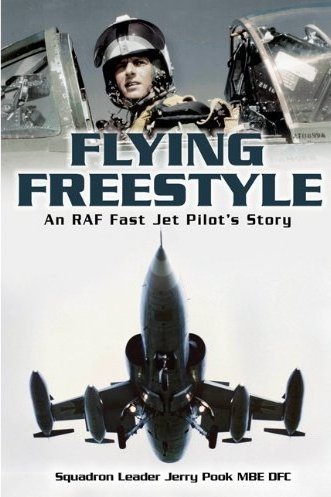 |
|
|
|
|
Roger
Cresswell (89A) was admitted and licensed as a Licensed Lay Minister of the Church of
England by the Bishop of Huntingdon, in a service held in Ely Cathedral on 18
Oct 2008. |
|
He
will serve in the Parish of Buckden with the Offords, (which I’m told are
villages rather than nice people who live there). Peter Crispin and
Click here to return to the top




